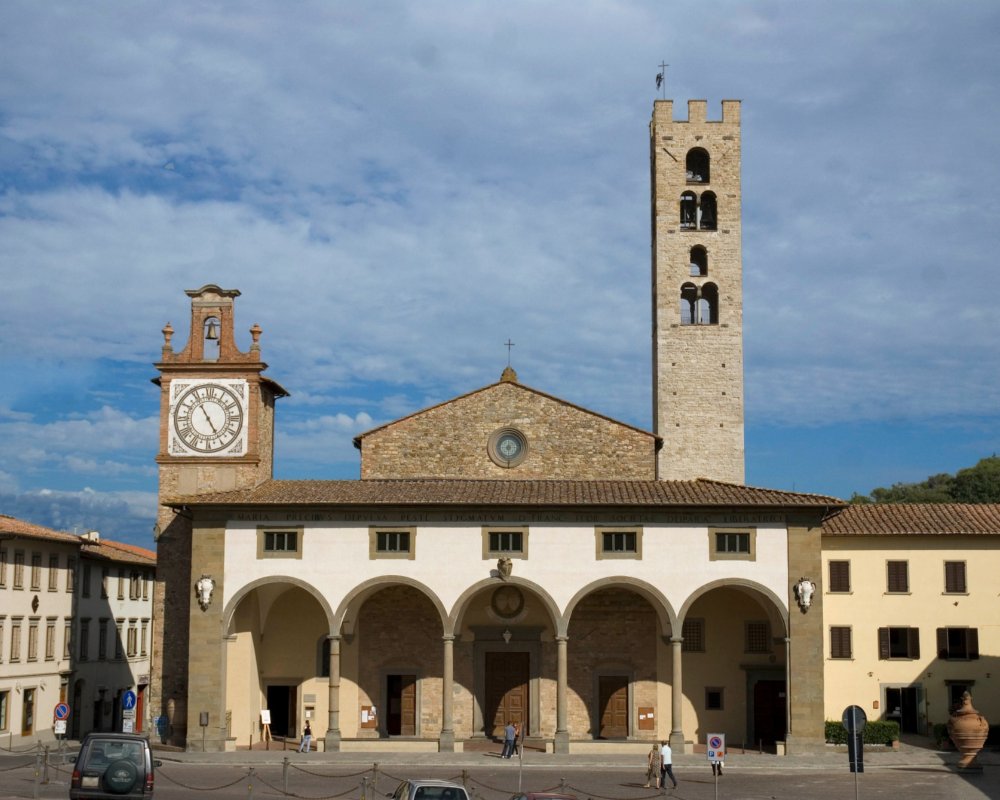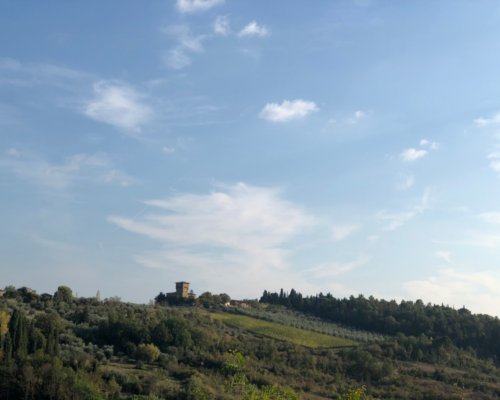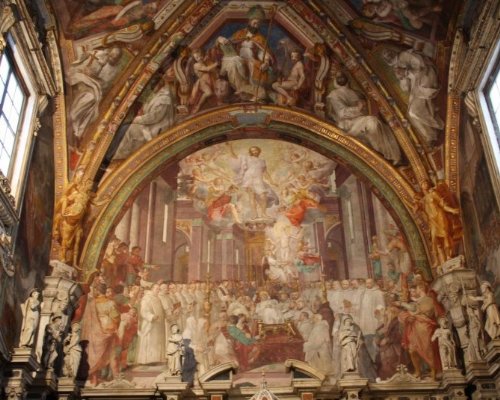Discover the surroundings of Florence and visit Galluzzo and Impruneta, land of the Acciaioli family and the cotto industry.
When you think about the surroundings of Florence you generally think about the Chianti area, but the Florentine hills, the so-called “Colli Fiorentini”, are the beautiful lands in between Florence, Chianti, Valdelsa, Mugello and other renowned areas. Here you find our suggestions for a 2 days itinerary to discover the area of Impruneta, where Brunelleschi came to buy the bricks for the Cupola, and visit the Charterhouse of Florence in Galluzzo.
Tips: this itinerary is suitable to any time of the year but we would like to let you know that on the last Sunday of September there is the beautiful Festa del Vino and the Fiera di San Luca, an old centuries feast to celebrate the city’s patron San Luca in the week before or next to October 25th.
Mentioned by Dante Alighieri in the Divine Comedy, Galluzzo is a small town, just 5 kilometers from Florence city center, that is part of the Quartiere 3 of Florence Municipality. It was one of the most populated areas of Florence surroundings until 1931, when the municipality of Galluzzo was discontinued and its area annexed to Florence, Scandicci and Impruneta.
Nowadays Galluzzo is famous for the presence of Florence Charterhouse, known as Certosa del Galluzzo or Certosa di Firenze, that was founded in 1341 by Niccolò Acciaioli. The Charterhouse is located on top of Monte Acuto where the Ema and Greve rivers join together, and it looks like a beautiful fortress still enclosed in massive walls. It’s been enlarged over the centuries and enriched with great artworks, and some of them are still there. The large complex includes the Churchos San Lorenzo, the Chapter house, the cloisters, the Sacristy, the Refectory and the cells of the monks. Among the artworks preserved inside the Certosa di Firenze you see 5 lunettes by Pontormo depicting the Passion of Christ - Pontormo stayed here a couple of years, between 1523 to 1525 to be safe from the terrible plague that was affecting Florence at that time. Not to be missed the stunning frescoes by Poccetti inside the Church of San Lorenzo and the wooden furniture.
Inside the Charterhouse there is a shop where you can buy the products made by the residents, like jams, candies and spirits.
Not too far from the Certosa, about 15 kilometers, there is the Fountain of the Fata Morgana supposed to be built in the the second half of the 16th century by Giambologna inside the estate of Bernardo Vecchietti. Legend has it that the water has magic powers: it makes people younger and can make you immortal; in addition they say that during summer nights beautiful women and fairies appear and party in the nearby.
Last part of this first day ends in Ponte a Ema where we suggest to visit the Bartali Cycling Museum, that is now part of Florence civic museums. It celebrates the great Italian biker Gino Bartali, who was born in Ponte a Ema in 1914 and won three Giri d’Italia, two Tour de France and many other important cycling races between 1936 to 1959 when he definitely stopped racing. The museum displays many original bikes, uniforms and documents of life and career of Gino Bartali and his rivals, like Fausto Coppi and Giuseppe Olmo.
Mentioned by Dante Alighieri in the Divine Comedy, Galluzzo is a small town, just 5 kilometers from Florence city center, that is part of the Quartiere 3 of Florence Municipality. It was one of the most populated areas of Florence surroundings until 1931, when the municipality of Galluzzo was discontinued and its area annexed to Florence, Scandicci and Impruneta.
Nowadays Galluzzo is famous for the presence of Florence Charterhouse, known as Certosa del Galluzzo or Certosa di Firenze, that was founded in 1341 by Niccolò Acciaioli. The Charterhouse is located on top of Monte Acuto where the Ema and Greve rivers join together, and it looks like a beautiful fortress still enclosed in massive walls. It’s been enlarged over the centuries and enriched with great artworks, and some of them are still there. The large complex includes the Churchos San Lorenzo, the Chapter house, the cloisters, the Sacristy, the Refectory and the cells of the monks. Among the artworks preserved inside the Certosa di Firenze you see 5 lunettes by Pontormo depicting the Passion of Christ - Pontormo stayed here a couple of years, between 1523 to 1525 to be safe from the terrible plague that was affecting Florence at that time. Not to be missed the stunning frescoes by Poccetti inside the Church of San Lorenzo and the wooden furniture.
Inside the Charterhouse there is a shop where you can buy the products made by the residents, like jams, candies and spirits.
Not too far from the Certosa, about 15 kilometers, there is the Fountain of the Fata Morgana supposed to be built in the the second half of the 16th century by Giambologna inside the estate of Bernardo Vecchietti. Legend has it that the water has magic powers: it makes people younger and can make you immortal; in addition they say that during summer nights beautiful women and fairies appear and party in the nearby.
Last part of this first day ends in Ponte a Ema where we suggest to visit the Bartali Cycling Museum, that is now part of Florence civic museums. It celebrates the great Italian biker Gino Bartali, who was born in Ponte a Ema in 1914 and won three Giri d’Italia, two Tour de France and many other important cycling races between 1936 to 1959 when he definitely stopped racing. The museum displays many original bikes, uniforms and documents of life and career of Gino Bartali and his rivals, like Fausto Coppi and Giuseppe Olmo.
Kick off your second day by visiting the Sanctuary of Santa Maria dell’Impruneta that was consecrated in 1060, where a miracle took place: when people decided to build a church dedicated to the Virgin Mary it happened that what they built during the day collapsed during the night. They went on for days and then decided to load the bricks on a cart and let the oxes go; after a while the oxes stopped and kneeled. The men started digging and found the image of the holy Virgin Mary. That was the place where they built the church that you see today and that became the destination of many pilgrimages. The venerated image of the Virgin Mary with Child is on display inside the church and used to be brought on procession to Florence Church of Santa Felicita in Piazza, until few years ago. Actually the sacred image of the Madonna from Impruneta is believed to be the savior of Florence and Florentine people from the terrible plague of 1630 - legend has it that the icon was brought on procession to Florence and the plague stopped. Next to the church there is the Museum of Sacred Art that hosts the collection and treasure of this rich sanctuary. Not to be missed the gold processional cross attributed to Lorenzo Ghiberti and the collection of choirbooks painted in miniature.
Impruneta is also the town of cotto, appreciated all over the world. The Cotto of Impruneta is a kind of terracotta, that is naturally rich in iron, very malleable, elastic and resistant. In Impruneta this terracotta has been produced since the Middle Ages and it was chosen by Filippo Brunelleschi to build the magnificent Cupola of Florence Cathedral. He used 4 millions of cotto bricks from the furnaces in Impruneta. Legend has it that Brunelleschi invented the famous Peposo all’imprunetina while he was working in the furnaces baking the Cupola’s bricks in Impruneta. Of course, if you’re in Impruneta you must eat the Peoposo, whose recipe has been recently “patented”.
Nowadays there are still many furnaces producing vases, jars and amphoras that are used also to produced wine - Vino in Anfora is the latest innovation in winemaking and most of the large jars are made here in a small family-run factory called Artenova Terracotta. Impruneta is in the Chianti Colli Fiorentini and it’s strongly related to winemaking, as you may see from the several wineries in the area. In addition every year, on the last Sunday of September wine is celebrated with one of the oldest feasts in Italy, Festa del vino. This colorful wine festival is unique: the four neighbourhoods of Impruneta create and build 4 large carts inspired to wine and put together a great show with hundreds of dancers in costumes.
Outside the city center, just if front of the historic Fornace Poggi, there is a big terracotta ring by contemporary artist Tuscan artist Mauro Staccioli, who wanted to create frame to the stunning view over the valley - you may see the same Staccioli’s artwork in Volterra. Last but not least, from Impruneta take the road to Tavarnuzze SP69 - along the road, just before Bagnolo you may spot Brunelleschi’s Cupola - and reach the Florence American Cemetery and Memorial in Falciani where are buried soldiers of the U.S. Fifth Army died in Italy during WWII.
Kick off your second day by visiting the Sanctuary of Santa Maria dell’Impruneta that was consecrated in 1060, where a miracle took place: when people decided to build a church dedicated to the Virgin Mary it happened that what they built during the day collapsed during the night. They went on for days and then decided to load the bricks on a cart and let the oxes go; after a while the oxes stopped and kneeled. The men started digging and found the image of the holy Virgin Mary. That was the place where they built the church that you see today and that became the destination of many pilgrimages. The venerated image of the Virgin Mary with Child is on display inside the church and used to be brought on procession to Florence Church of Santa Felicita in Piazza, until few years ago. Actually the sacred image of the Madonna from Impruneta is believed to be the savior of Florence and Florentine people from the terrible plague of 1630 - legend has it that the icon was brought on procession to Florence and the plague stopped. Next to the church there is the Museum of Sacred Art that hosts the collection and treasure of this rich sanctuary. Not to be missed the gold processional cross attributed to Lorenzo Ghiberti and the collection of choirbooks painted in miniature.
Impruneta is also the town of cotto, appreciated all over the world. The Cotto of Impruneta is a kind of terracotta, that is naturally rich in iron, very malleable, elastic and resistant. In Impruneta this terracotta has been produced since the Middle Ages and it was chosen by Filippo Brunelleschi to build the magnificent Cupola of Florence Cathedral. He used 4 millions of cotto bricks from the furnaces in Impruneta. Legend has it that Brunelleschi invented the famous Peposo all’imprunetina while he was working in the furnaces baking the Cupola’s bricks in Impruneta. Of course, if you’re in Impruneta you must eat the Peoposo, whose recipe has been recently “patented”.
Nowadays there are still many furnaces producing vases, jars and amphoras that are used also to produced wine - Vino in Anfora is the latest innovation in winemaking and most of the large jars are made here in a small family-run factory called Artenova Terracotta. Impruneta is in the Chianti Colli Fiorentini and it’s strongly related to winemaking, as you may see from the several wineries in the area. In addition every year, on the last Sunday of September wine is celebrated with one of the oldest feasts in Italy, Festa del vino. This colorful wine festival is unique: the four neighbourhoods of Impruneta create and build 4 large carts inspired to wine and put together a great show with hundreds of dancers in costumes.
Outside the city center, just if front of the historic Fornace Poggi, there is a big terracotta ring by contemporary artist Tuscan artist Mauro Staccioli, who wanted to create frame to the stunning view over the valley - you may see the same Staccioli’s artwork in Volterra. Last but not least, from Impruneta take the road to Tavarnuzze SP69 - along the road, just before Bagnolo you may spot Brunelleschi’s Cupola - and reach the Florence American Cemetery and Memorial in Falciani where are buried soldiers of the U.S. Fifth Army died in Italy during WWII.


